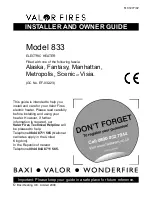
www.desatech.com
104415-01M
7
Confined and Unconfined Space
The
National Fuel Gas Code, ANSI Z223.1/NFPA
54
defines a confined space as a space whose
volume is less than 50 cubic feet per 1,000 Btu
per hour (4.8 m
3
per kw) of the aggregate input
rating of all appliances installed in that space and
an unconfined space as a space whose volume is
not less than 50 cubic feet per 1,000 Btu per hour
(4.8 m
3
per kw) of the aggregate input rating of
all appliances installed in that space. Rooms com-
municating directly with the space in which the
appliances are installed*, through openings not
furnished with doors, are considered a part of the
unconfined space.
* Adjoining rooms are communicating only if
there are doorless passageways or ventilation grills
between them.
DETERMINING FRESH-AIR FLOW
FOR HEATER LOCATION
Determining if You Have a Confined or
Unconfined Space
Use this work sheet to determine if you have a
confined or unconfined space.
Space:
Includes the room in which you will install
heater plus any adjoining rooms with doorless pas-
sageways or ventilation grills between the rooms.
1. Determine the volume of the space (length x
width x height).
Length x Width x Height =__________cu. ft.
(volume of space)
Example:
Space size 20 ft. (length) x 16 ft.
(width) x 8 ft. (ceiling height) = 2,560 cu. ft.
(volume of space)
If additional ventilation to adjoining room is
supplied with grills or openings, add the volume
of these rooms to the total volume of the space.
2. Multiply the space volume by 20 to determine
the maximum Btu/Hr the space can support.
__________ (volume of space) x 20 = (Maxi-
mum Btu/Hr the space can support)
Example:
2,560 cu. ft. (volume of space) x 20 =
51,200 (maximum Btu/Hr the space can support)
AIR FOR COMBUSTION
AND VENTILATION
Continued
3. Add the Btu/Hr of all fuel burning appliances in
the space.
Vent-free fireplace
__________ Btu/Hr
Gas water heater*
__________ Btu/Hr
Gas furnace
__________ Btu/Hr
Vented gas heater
__________ Btu/Hr
Gas fireplace logs
__________ Btu/Hr
Other gas appliances* + __________ Btu/Hr
Total
= __________ Btu/Hr
* Do not include direct-vent gas appliances. Di-
rect-vent draws combustion air from the outdoors
and vents to the outdoors.
Example:
Gas water heater
__________ Btu/Hr
Vent-free fireplace
+ __________ Btu/Hr
Total
= __________ Btu/Hr
4. Compare the maximum Btu/Hr the space can
support with the actual amount of Btu/Hr used.
_________Btu/Hr (maximum the space can support)
_________ Btu/Hr (actual amount of Btu/Hr used)
Example:
51,200 Btu/Hr (maximum the space
can support)
73,000 Btu/Hr (actual amount of
Btu/Hr used)
The space in the example is a confined space because
the actual Btu/Hr used is more than the maximum
Btu/Hr the space can support. You must provide ad-
ditional fresh air. Your options are as follows:
A. Rework worksheet, adding the space of an adjoin-
ing room. If the extra space provides an unconfined
space, remove door to adjoining room or add
ventilation grills between rooms. See
Ventilation
Air From Inside Building,
page 8.
B. Vent room directly to the outdoors. See
Ventila-
tion Air From Outdoors,
page 8.
C. Install a lower Btu/Hr fireplace, if lower Btu/Hr
size makes room unconfined.
If the actual Btu/Hr used is less than the maximum
Btu/Hr the space can support,
the space is an uncon-
fined space. You will need no additional fresh air
ventilation.
WARNING: If the area in
which the heater may be oper-
ated is smaller than that defined
as an unconfined space or if the
building is of unusually tight
construction, provide adequate
combustion and ventilation air
by one of the methods described
in the
National Fuel Gas Code,
ANSI Z223.1/NFPA 54 Section 5.3
or applicable local codes.
40,000
33,000
73,000








































